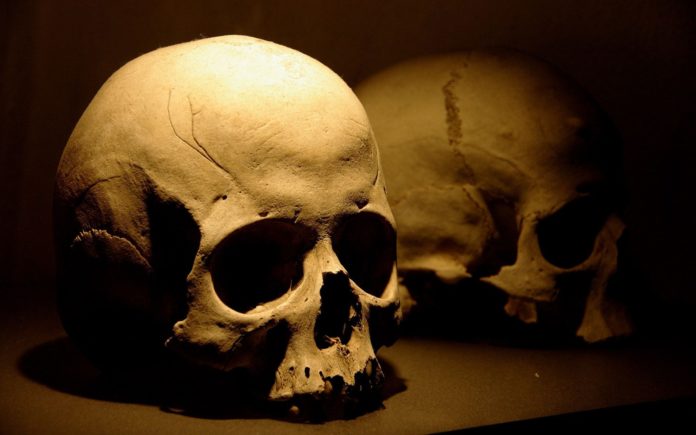Five men were on Thursday brought before a Yaba Chief Magistrates’ court in Lagos for alleged possession of human skulls.
The defendants are: Adekunle Mufutau, 50, Abdulwaheed Omolewa, 46, Adeleke Nosiru, 45, Kazeem Laisisi, 36, and Babatunde Omoleye, 30.
They are facing a two-count charge of conspiracy and unlawful possession of human parts.
They, however, pleaded not guilty to charge.
The Prosecutor, Asp. Rita Momah, told the court that the defendants committed the offences on March 16, at Agbowa Ikosi, area near Lagos.
According to her, the defendants broke into Brewery Cemetery in Agbowa Ikosi in the middle of the night and dug up many decomposed bodies that were buried there.
READ ALSO: Voodoo Fraudsters Scams Sick Woman Of N250M
She said the defendants cut off the skull of the bodies and took them for ritual purposes.
Momah said it was the grave keeper that saw them and called the attention of the local vigilante group that subsequently caught them and took them to the police station.
The alleged offences contravene Sections 411 and 238 of the Criminal Law of Lagos State, 2015 (Revised).
Section 238 stipulates a 14-year jail term for unlawful possession of human part, while 411 provides for two years’ imprisonment for conspiracy.
Chief Magistrate, Mrs Adeola Adedayo, granted the defendants bail in the sum of N200,000 each with two sureties in like sum.
She said one of the sureties must be a blood relation to each defendant and that both sureties should be gainfully employed.
Adedayo also directed that the sureties should reside within the court’s jurisdiction and show evidence of three years’ tax payment to the Lagos State government.
The case was adjourned until May 9 for mention.
The skull is a bone structure that forms the head in vertebrates. It supports the structures of the face and provides a protective cavity for the brain. The skull is composed of two parts: the cranium and the mandible. In humans, these two parts are the neurocranium and the viscerocranium (facial skeleton) that includes the mandible as its largest bone. The skull forms the anterior-most portion of the skeleton and is a product of cephalisation—housing the brain, and several sensory structures such as the eyes, ears, nose, and mouth. In humans these sensory structures are part of the facial skeleton.
READ ALSO: How My One-Month-Old Baby Fell From My Hand And Die – Father
Functions of the skull include protection of the brain, fixing the distance between the eyes to allow stereoscopic vision, and fixing the position of the ears to enable sound localisation of the direction and distance of sounds. In some animals, such as horned ungulates (mammals with hooves), the skull also has a defensive function by providing the mount (on the frontal bone) for the horns.
The English word skull is probably derived from Old Norse skulle, while the Latin word cranium comes from the Greek root κρανίον (kranion). The human skull fully develops two years after birth. The junctions of the skull bones are joined together by structures called sutures.
The skull is made up of a number of fused flat bones, and contains many foramina, fossae, processes, and several cavities or sinuses. In zoology there are openings in the skull called fenestrae.

